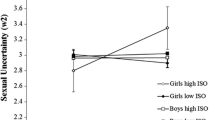Abstract
Surveys in 10 states conducted with probability samples of adults (N =4621) between 1976 and 1985 found that a statistically significant majority of the respondents in each state indicated acceptance of sexually explicit content in mass media. In each state, respondents felt that (i) standards have changed so that such material has become more acceptable; (ii) adults have the right to obtain such materials; and (iii) it is all right for adults to obtain and see materials containing exposure of the genitalia and every kind of sexual activity. Some factors contributing to what appears to be an emerging national consensus of acceptance are discussed.
Similar content being viewed by others
References
Abelson, H. I., Cohen, R., Heaton, E., and Suder, C. (1971). Public attitudes toward and experience with erotic materials. InCommission on Obscenity and Pornography, Technical Report, Vol. 6., U.S. Government Printing Office, Washington, DC, pp. 139–141.
Attorney General. (1986).Final Report of the Commission on Pornography U.S. Department of Justice, Washington, DC.
Bishop, Y. M., Fienberg, S. E., and Holland, P. W. (1975).Discrete Multivariate Analysis: Theory and Practice MIT Press, Cambridge, MA.
“Charting the adult video market.” (1989).Adult Video News 1989 Buyer's Guide, pp. 6–7.
Commission on Obscenity and Pornography. (1971).Final Report Government Printing Office, Washington, DC.
Davis, J. A., and Smith, T. W. (1991).The General Social Survey 1972–1991: Cumulative Code Book National Opinion Research Center, Chicago.
Diamond, M., and Dannemiller, M. A. (1989). Pornography and community standards in Hawaii: Comparisons with other states.Arch. Sex. Behav. 18: 475–495.
Dworkin, A. (1989).Pornography: Men Possessing Women Dutton, New York.
Fahringer, H. P. (1975). Appellants reply briefin re People of the State of New York v. J. Buckley and A. Goldstein, State Court of Appeals, pp. 1–18.
Garbus, M. (1990). Thornburgh's morality brigade.New York Times, April 28 p. 34.
Gest, T. (1989). The drive to make America porn-free,Newsweek, February 6, p. 26.
Glenn, N. D., and Simmons, J. L. (1967). Are regional culture differences diminishing,P. O. Q. 31: 176–193.
Gould, J. (1992). Topless bars want your husband.Redbook 179(5): 118–121.
Grant, W. V., and Snyder, T. D. (1986).Digest of Education Statistics 1985–1986 U.S. Government Printing Office, Washington, DC.
Herrman, M. S., and Bordner, D. C. (1983). Attitudes toward pornography in a southern community,Criminology, 349–374.
Jackson, G., Masnick, G., Bolton, R., Bartlett, S., and Pitkin, J. (1981).Regional Diversity: Growth in the United States 1960–1990 Auburn House, Boston, pp. 1–10.
Miller v. California (1973). 413 U.S. 153.
Mackinnon, C. A. (1989).Toward A Feminist Theory of the State Harvard University Press, Cambridge, MA.
New York v. Ferber. (1982). 102 S. Ct. 3357, n. 12.
Nobile, P. (ed.), (1970).The New Eroticism: Theories, Vogues, and Canons Random House, New York.
Obscenity Research Project. (1977). An empirical inquiry into the effects ofMiller v. California on the control of obscenity.New York Univ. Law R. 52: 810–939.
Quinn, B., Anderson, H., Bradley, M., Goetting, P., and Shriver, P. (1980).Churches and Church Membership in the United States Glenmary Research Center, Atlanta, GA.
Reynolds, H. T. (1977).The Analysis of Cross-Classifications Free Press, Riverside, NJ.
Scott, J. E. (1991). What is obscene? Social science and the contemporary community standard test of obscenity.Int. J. Law Psychiat. 14: 29–45.
Seldin, C. (1984). Vote rejecting cable measure by a 3—2 ratio.Salt Lake Tribune, November 7, p. 1.
Straus, M. A. (1985). The validity of U.S. States as units for sociological research. Paper delivered at the annual meeting of the American Sociological Association.
Winick, C. (1977). From deviant to normative: Changes in the social acceptability of sexually explicit material. In Sagarin, E. (ed.),Deviance and Social Change Sage, Beverly Hills. pp. 219–246.
Straus, M. A. (1985). The validity of U.S. States as units for sociological research. Paper delivered at the annual meeting of the American Sociological Association.
Winick, C. (1977). From deviant to normative: Changes in the social acceptability of sexually explicit material. In Sagarin, E. (ed.),Deviance and Social Change Sage, Beverly Hills. pp. 219–246.
Woodward, B., and Armstrong, S. (1979).The Brethren: Inside the Supreme Court Simon and Schuster, New York, pp. 192–204.
Zevin, D. (1992). Sex in entertainment: How far can it go?US August, pp. 32–37.
Author information
Authors and Affiliations
Rights and permissions
About this article
Cite this article
Winick, C., Evans, J.T. Is there a national standard with respect to attitudes toward sexually explicit media material?. Arch Sex Behav 23, 405–419 (1994). https://doi.org/10.1007/BF01541406
Issue Date:
DOI: https://doi.org/10.1007/BF01541406




